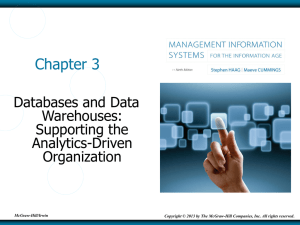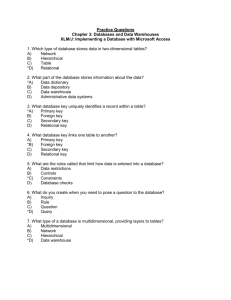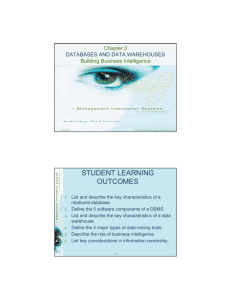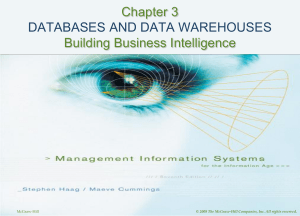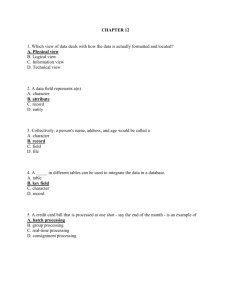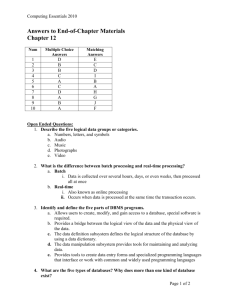Basic Marketing, 16e
advertisement
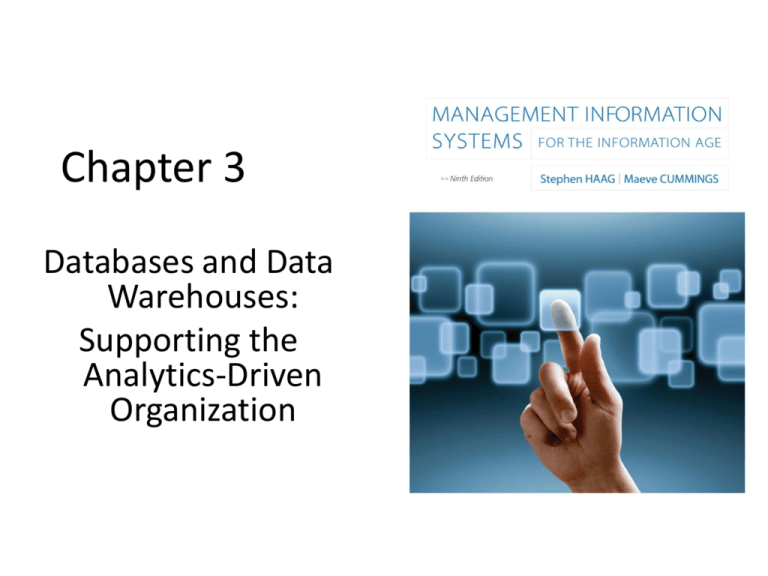
Chapter 3 Databases and Data Warehouses: Supporting the Analytics-Driven Organization STUDENT LEARNING OUTCOMES 1. List and describe the key characteristics of a relational database. 2. Define the 5 software components of a DBMS. 3. List and describe the key characteristics of a data warehouse. 4. Define the 5 major types of data-mining tools. 5. List key considerations in information ownership. DID YOU KNOW CDs COME FROM DEAD DINOSAURS? In 2010, more than half of all music was in digital form; physical music will never again be the norm Questions 1. How many digital music devices do you use? 2. How many CDs do you own that you bought from a retail store? 3. When was the last time you bought music on a physical medium such as a CD? INTRODUCTION • Business intelligence (BI) – collective information that gives you the ability to make effective, important, and strategic business decisions • Analytics – the science of fact-based decision making • Both are important in today’s business world INTRODUCTION • Businesses use many IT tools to manage and organize information • Online transaction processing (OLTP) – gathering and processing information and updating existing information to reflect the processed information • Online analytical processing (OLAP) – manipulation of information to support decision making INTRODUCTION • OLTP – Supports operational processing, i.e., day-today activities – Object is information associated with routine transactions such as sales, product orders, accounts receivable, etc – Supported by operational databases & DBMSs • OLAP – Helps build business intelligence – Supported by data warehouses and datamining tools OLTP, OLAP, and Business Intelligence RELATIONAL DATABASE MODEL • Database – collection of information – organized and accessed – according to the logical structure of the information • Relational database – series of logically related two-dimensional tables or files for storing information – Relation = table = file – Most popular database model Database Characteristics • Collections of information • Created with logical structures • Include logical ties within the information • Include built-in integrity constraints Database – Collection of Information Database – Created with Logical Structures • Data dictionary – contains the logical structure for the information in a database Before you can enter information into a database, you must define the data dictionary for all the tables and their fields. For example, when you create the Truck table, you must specify that it will have three pieces of information and that Date of Purchase is a field in Date format. Database – Logical Ties within the Information • Primary key – field (or group of fields) that uniquely describes each record • Foreign key – primary key of one file that appears in another file Customer Number is the primary key for Customer and appears in Order as a foreign key Database – Logical Ties within the Information Databases – Built-In Integrity Constraints • Integrity constraints – rules that help ensure the quality of information • Data dictionary, for example, defines type of information – numeric, date, and so on • Foreign keys – must be found as primary keys in another file – E.G., a Customer Number in the Order Table must also be present in the Customer Table • Default Values and Validation Rules DATABASE MANAGEMENT SYSTEM TOOLS • Database management system (DBMS) – helps you specify the logical requirements for a database and access and use the information in a database 5 Components of a DBMS 1. 2. 3. 4. 5. DBMS engine Data definition subsystem Data manipulation subsystem Application generation subsystem Data administration subsystem DBMS Engine • DBMS engine – accepts logical requests and converts them into the physical equivalents, and accesses the database and data dictionary on a storage device • Physical view – how information is physically arranged, stored, and accessed on a storage device • Logical view – how you need to organize and access information to meet your needs Data Definition Subsystem • Data definition subsystem – used to create and maintain the data dictionary and structure of the files in a database • The data dictionary helps you define… – Tables – Field names – Data types (numeric, etc) – Form (do you need an area code) – Default values – Is an entry required, etc Data Manipulation Subsystem • Data manipulation subsystem – used to add, change, and delete information in a database and query it to find valuable information • Usually your primary interface – includes – Forms – Views – Report generators – Query-by-example tools – Structured query language Form Form – used to add, delete and change/update data in a database information View View – allows you to see the contents of a database file, make changes, and query it to find information Report Generator Report generator – used to define formats of reports and identify information y in the report Query-by-Example Tool QBE tool – used to graphically design the answer to a question Structured Query Language • SQL – standardized fourth-generation query language found in most DBMSs • Sentence-structure equivalent to QBE • Mostly used by IT professionals • Example – the following SQL logic generates the view on the following page – SELECT Employee.LastName, Sale.SaleDate, SaleItem.Description, SaleItem.Quantity, SaleItem.SalePrice – FROM Employee INNER JOIN (Sale INNER JOIN SaleItem ON Sale.SaleID = SaleItem.SaleID) ON Employee.EmployeeID = Sale.EmployeeID; Employee Sales Query Application Generation Subsystem • Application generation subsystem – contains facilities used to develop transaction-intensive applications • Mainly used by IT professionals Data Administration Subsystem • Data administration subsystem – helps you manage the overall database environment by providing facilities for… – Backup and recovery – Security management – Query optimization – Reorganization – Concurrency control – Change management Data Administration Subsystem • Backup and recovery – for backing up information and restarting (recovering) from a failure – Backup – copy of information on a computer – Recovery – process of reinstalling the backup information in the even the information was lost Data Administration Subsystem • Security management – for CRUD access – create, read, update, and delete • Query optimization – to minimize response times for large, complex queries • Reorganization – for physically rearranging the structure of the information according to how you most often access it Data Administration Subsystem • Concurrency control – what happens if two people attempt to make changes to the same record • Change management – how will structural changes impact the overall database DATA WAREHOUSES AND DATA MINING • Help you build and work with BI and some forms of knowledge • Data warehouse – collection of information from many databases – supports business analysis and decision making • Multidimensional – Rows, columns, and layers • Support decision making, not transaction processing – Contain summaries of information – Not every detail Data Warehouse Data Warehouse Demo • Funky Animated Data Warehouse Demo Data Mining Toolset of Analytics Professional Data Mining Toolset of Analytics Professional • Query-and-reporting tools – similar to QBE tools, SQL, and report generators • Artificial intelligence – tools to help you “discover” information and trends (more in Chapter 4) • Multidimensional analysis (MDA tools) – slice-and-dice techniques for viewing multidimensional information Data Mining Toolset of Analytics Professional • Digital dashboard – displays key information on a computer screen tailored to the needs and wants of an individual • Key performance indicator (KPI) – most essential information used in any analytics initiative • Statistical tools – for applying mathematical models to data warehouse information Digital Dashboard Data Warehouse • NetSuite Business Intelligence Demo • Data mining with SQL Server and Excel: Detecting Categories • Data mining with SQL Server and Excel: Forecasting The Analytics Life Cycle Extraction, Transformation, and Loading (ETL) • ETL is a three-step process 1. Extract needed information from its source 2. Transform the data into a standardized format 3. Load the transformed data into a data warehouse Data Marts • Data mart – subset of a data warehouse in which only a focused portion of the data warehouse information is kept Data Warehouse Considerations • Do you really need one, or does your database environment support all your functions? • Do all employees need a big data warehouse or a smaller data mart? • How up-to-date must the information be? • What data-mining tools do you need? INFORMATION OWNERSHIP • Information is a resource you must manage and organize to help the organization meet its goals and objectives • You need to consider – Strategic management support – Sharing information with responsibility – Information cleanliness Strategic Management Support • CIO – every aspect of an organization’s information resource • CTO – the underlying IT infrastructure and user-facing technologies • CSO – technical aspects for security of information • CPO – information is used in an ethical way Strategic Management Support • 2 others in information management • Data administration – function that plans for, oversees the development of, and monitors the information resource • Database administration – function responsible for the more technical and operational aspects of managing organizational information Sharing Information • Everyone can share – while not consuming – information • But someone must “own” it by accepting responsibility for its quality and accuracy Information Cleanliness • Related to ownership and responsibility for quality and accuracy • No duplicate information • No redundant records with slightly different data, such as the spelling of a customer name • GIGO – if you have garbage information you get garbage information for decision making
